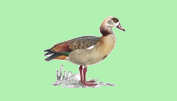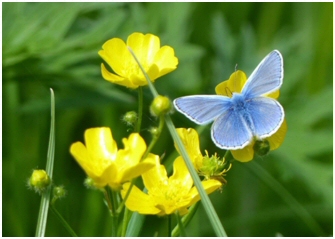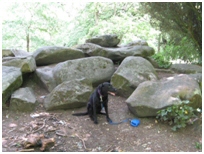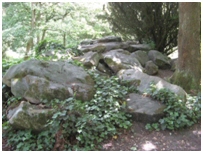Newsletter
Current
Previous
|
August 2015
|
|
|
|
|
 How time flies How time flies
Spring, a wonderful time of year, went by all too quickly and summer is almost ended, but this newsletter reminds us of some of the seasonal sights seen in Earley. Summer was notable for the beds of nectar-rich flowers throughout Earley, to give a boost to local wildlife, and also much appreciated by local residents.
We are also surrounded by the built environment, which can be appreciated, or not, depending on your taste. Read about one structure over 200 years old, and another about 50 years old.
A couple of things you may not know about Earley…
We have trees on Earley streets that dinosaurs may have grazed on.
A duke bankrupted himself trying to make his Earley garden the best in the country, and there are still remains of his great project.
The Earley Environmental Group - ten years old
Its existence and service to the community has been due to the efforts of a few individuals. We urgently need an injection of new blood, so if you have an interest in the local environment, and are willing to help in some way however small, there are a variety of ways: perhaps contacting the local media, using IT skills, overseeing venues and arrangements for talks or physical labour in Maiden Erlegh Reserve etc. See here for contact details.
We also owe a special thanks to Oracle Software, which has made it possible for us to produce our newsletters, now up to issue 40, by printing all but one of them, free of cost.
|
|
|
|
Maiden Erlegh Lake
in spring and early summer
After a mild winter, which saw visiting birds such as a tufted duck and a rather rarer egret passing through, March ushered in spring and its promise of new life. By mid-month there was definitely a sense of seasonal vitality, with ducks chasing and pairing, coots fighting, last year's grown-up cygnet separating from its parents, grebes arriving from their winter sojourn. I thought it might be interesting to trace the family fortunes of one of the more prominent birds on the lake - the Egyptian Goose (more on M.E. water birds on the EEG website).
Back after an absence of several years, early sightings in February were for a pair of Egyptian geese, but soon only one was in evidence. The male, assuming that is what it was, remained conspicuous, displaying a partiality for standing on the handrail at the feeding station. On 4th April, however, the pair were seen together again, leading a flotilla of five goslings out on the water from Big Island to the longer-established silt pocket. Sadly, five had become four by 6 April, and so remained until 15 May, when the family was further depleted.
The adults were back on the handrail on 11 May and, subsequently, when the two newer silt pockets on Lakeside had found greater favour, on the rail opposite the Duck & the World. Adult feathers were sprouting by mid-May as the goslings grew in stature and bulk, but they still tended to cluster together for warmth and security; on 27 May they were in a heap, breathing in measured synchronicity. The closely-knit family started to loosen its bonds in June as from the 5th the goslings could be seen swimming independently of their parents. The male in particular appeared increasingly detached, often standing apart, seemingly on guard, or sometimes, by the end of the month, alone. But as July opened the family was still together, the youngsters in their new flight feathers almost indistinguishable from their parents as they continue to cluster by the silt pockets, or take to perching on the 'Fallen Tree' between Swan Island and the reed bed.
Edwin Trout

|
Our volunteers help with projects
EEG members, supporting Grahame Hawker of Earley Town Council Park Rangers, have contributed to the maintenance and improvement of the Reserve. Below are just two of the flower beds created, and the new raised walkway in the wetland part of the reserve.

Lakeside entrance

Butterfly garden,
Instow Rd

Raised path
|
|
|
|
Road Verges - A Sanctuary for Animals
The need for sanctuaries on our road verges to create havens for threatened wildflowers and pollinators cannot be emphasised enough. When these are cut down it robs bees and insects of a source of nectar and pollen. A staggering 97% of meadows, home to many beautiful wildflowers and insects, have been destroyed since the 1930s.
THE VALUE OF ROADSIDE VERGES:
Charity Plantlife.org.uk has launched Road Verge Campaign 2015, having found that Britain's roadside verges are home to 703 species of wild plants: that's more than any other part of our landscape. So many of our favourite wildflowers, like ox-eye daisy, grow on verges. If the right plants can be encouraged to grow, they will spread, many helped by the slipstream from passing vehicles. Plantlife cites that it's been estimated that pyramidal orchids on the 6-mile Ilminster Bypass (Somerset) generate 114 million seeds, which will be carried for miles in the slipstream of cars and lorries. Many other perennial flowers, such as cowslips and knapweeds, will spread quickly once allowed to flower and set seed.
MANAGEMENT OF VERGES:
Just leaving them to their own devices doesn't work. They become overgrown with rank growth, crowding out the wildflowers. A regime of the right time for cutting and for raking up makes all the difference, allowing seed to set and avoiding enriching the soil too much (most wildflowers do not thrive on enriched soil). The need for road safety also has to be taken into consideration. Having such verges is not a means of saving money on grass cutting. The management is quite complex to get the best value for wildlife from these areas. Wokingham Borough Council has begun with some pilot sites in Woodley and Wokingham. Read the philosophy behind this on the Wokingham Borough Council website.
|
|
A few wild orchids have recently been noted in Earley verges, appearing as though from nowhere - a small miracle.
L to R: Common Spotted Orchid, Bee Orchid, Pyramidal Orchid, Helleborine (Photos: Anne Booth)

|
|
|
BUTTERFLIES IN EARLEY
 This lovely photo was taken by member, David Jupe, and shows a male common blue Polyommatus icarus on buttercups.
This lovely photo was taken by member, David Jupe, and shows a male common blue Polyommatus icarus on buttercups.
Some facts about the common blue:
Habitat: rough, open ground, chalk downland and wild grassy places. In warm years, finds its way into gardens.
Foodplants: clovers, medick, trefoils, rest-harrow and other Leguminosae.
It's the most widespread blue found in the British Isles.
(Source: British Butterflies A Field Guide Robert Goodden)
 Here's one butterfly you won't find in Earley. Featured as a quiz question in the last newsletter, it's the Duke of Burgundy. The connection with Earley is that it's the title of a film, directed and written by Peter Strickland, who was raised in Earley. Peter has received many accolades for his films and is considered to be an 'increasingly vital British filmmaker' (Telegraph film critic); the Guardian critic describes him as 'a key British film-maker of his generation'. It's not a cosy documentary and has an '18' rating, but is concerned with the fraught relationship between two women, one a lepidopterist. Here's one butterfly you won't find in Earley. Featured as a quiz question in the last newsletter, it's the Duke of Burgundy. The connection with Earley is that it's the title of a film, directed and written by Peter Strickland, who was raised in Earley. Peter has received many accolades for his films and is considered to be an 'increasingly vital British filmmaker' (Telegraph film critic); the Guardian critic describes him as 'a key British film-maker of his generation'. It's not a cosy documentary and has an '18' rating, but is concerned with the fraught relationship between two women, one a lepidopterist.
On the subject of the butterfly, not the film, Martin Warren, Chief Executive of Butterfly Conservation, blogged the story of his Big Butterfly Hike along the Jurassic Coast of Devon and Dorset, from Monday 27th July to Sunday 2nd August, a sponsored hike to raise money for three of our most threatened butterflies, the High Brown Fritillary, Wood White and Duke of Burgundy.
It may not be too late to sponsor him. You can also sign up for the e-newsletter.
|
|
Hillside School Fair
EEG had a stand at the fair and ran a competition for children, the prize for which was a butterfly identification chart.
Congratulations to the winner, Corey Amoah. He should now be able to identify a common blue when he sees one.
National Bird Campaign - in a recent national vote to find the country's favourite bird, the robin came first, with barn owl second, and blackbird third.
|  |
|
|
|
REMINDER OF TIMES PAST
You just had to have a grotto if you were anyone. Earley resident, the Marquess of Blandford of Whiteknights, later fifth Duke of Marlborough, just had to have one, in addition to those thousands of plants brought at great expense from abroad, purchased from intrepid plant- hunters. Perhaps we all know the feeling, "I must have that plant", but he pursued it to a point of madness. He ruined himself in the pursuit. For example, for 22 plants of Magnolia grandiflora, he paid what would be the equivalent today of £60,000. He set out to create one of the great gardens in the country.

The fountains
would have been
below the entrance
There are vestiges of this great endeavour left, some unusual trees and the remains of an ice-house in the University of Reading grounds. Near the modern rustic bridge (the original was 'made entirely from the roots and branches of trees in their natural state, around which ivy is entwined') lies an imposing pile of massive stones - the remains of the grotto. Local people tell me they have referred to these stones as 'the Indian stones'. Anyone know why?
I felt the urge to find out more about it when walking the dog in Whiteknights, and we became joint sleuths, searching for hidden clues in the surrounding grassland, the dog doing a great job of checking the grass. I did find some very large boulders covered with earth and grass lying near the grotto, and remains of a pebbled floor, but nothing else. (By this time I was into writing myself into a child's adventure book, with my trusty companion, Saffie, at my side. But we all know that there is little new to discover where someone hasn't been there before, and the dream faded). I did wonder about the unfortunate men and horses whose job it was to erect such grottoes. There were specialists to design them.
It is hard to imagine the former glory of the grotto, but the description fortunately exists in the folio volume the Duke commissioned in 1816 from Barbara and Thomas Hofland, respectively writer and artist, to describe the Whiteknights estate.
Two fountains* mark the entrance to the grotto, which has the appearance of a rocky Cavern. Within, a magic effect has been contrived: from the rocky roof descend branches of coral; seaweeds are mixed with ferns; pink, black and white conches abound, and masses of glittering violet spar, white 'chrystals', ores and nautili; clams and large shells decorate the entrance.'
After our sleuthing I thought it time to repair to the nearby cottage, 'delightfully fitted up as tea-rooms' (Mrs. Hofland); unfortunately it had closed nearly two centuries before.
Footnote: *The remains of a fountain were spotted among rubble being removed, I believe, in the 1960s.
Sheila Crowson

Fellow sleuth, Saffie.
|
 |
Sources:
Shell Houses & Grottoes, Shire Library 398
The Profligate Duke by Mary Soames |
|
|
Traffic Growth on the M4 - Losing the hard shoulder from J3 to J12
Highways England (formerly the Highways Agency) has plans to cater for increased traffic on the M4 by converting the hard shoulder to use as an additional lane, requiring 11 bridges to be replaced, at a cost of up to £862 million.
Proposal is for a 'Smart Motorway':
Gantries, cameras, speed controls etc.: likely to improve safety, reduce congestion, and slightly increase peak hour traffic volume (more traffic can flow safely and smoothly at around 55 mph than if drivers are allowed to go at 70 mph) … and …
'all-lane running' - there is no hard shoulder, just an additional lane for traffic and 'refuges' every 2.5 km, leading to a significant increase in capacity, but breakdowns and accidents must be more likely to cause lane closures.
Air quality is a key issue because the proposals show that it will be made worse by traffic growth, and the UK Supreme Court has recently ruled, in response to ClientEarth, that the government must make plans for tackling the UK's air pollution problem, which has been in breach of EU limits for years and is linked to thousands of premature deaths each year. Many roads into Reading are already Air Quality Management Areas, which Defra says are, "places where the objectives are not likely to be achieved".
Climate change doesn't get much acknowledgement from Highways England, despite a calculation that the scheme will result in a total of 4 million tonnes of extra CO2 over the 60-year assessment period. We would want to see a significant reduction.
Reading Friends of the Earth have objected to the use of the hard shoulder on grounds of: reduced safety; increase in traffic which will affect noise, air quality and climate change; loss of capacity to cope with accidents; and unnecessary cost. They have argued that a managed motorway with speed controls and lane management, keeping the hard shoulder as at present, could be implemented relatively quickly and at relatively low cost, bringing rapid relief to congestion on the M4, with improved safety, whilst retaining the benefits of the hard shoulder in case of emergencies and/or lane closures for maintenance.
The period to register as objectors to the scheme is now over. It goes to formal Examination in the autumn. For more details please see Reading FOE website. See also: Campaign for Better Transport and National Infrastructure Planning.
John Booth
|
|
A tree as old as the dinosaurs - in Earley!
 Trees known to the dinosaurs are alive and well in Earley. A couple have been planted on the verges of an Earley road. I'm talking about the Ginkgo tree. A unique tree, Ginkgo biloba is a species not related to any known living plant, and its oldest fossil is 200 million years old.. Trees known to the dinosaurs are alive and well in Earley. A couple have been planted on the verges of an Earley road. I'm talking about the Ginkgo tree. A unique tree, Ginkgo biloba is a species not related to any known living plant, and its oldest fossil is 200 million years old..
The outer part of its seed bears a smell likened to vomit (fear not, the majority of street trees are male and do not produce seed). One idea by researchers is that this may have attracted extinct mammals and dinosaurs to it, and so the seed was spread.
Experts think it was wiped out by the ice age, except in China. It's estimated to have first been cultivated there by humans several thousand years ago, perhaps for its nuts
 The first Westerner to write about it was an employee of the Dutch East India Company in Japan in 1692, and it was probably introduced into Europe in the mid-1700s by Western plant collectors. The first Westerner to write about it was an employee of the Dutch East India Company in Japan in 1692, and it was probably introduced into Europe in the mid-1700s by Western plant collectors.
It is thought to have medicinal properties, helping with short-term memory loss. The Chinese and Japanese make use of the nuts, while the West pursues its use mainly with leaves. The medicinal properties claimed for many health problems have not been decisively proved. Beware: parts of the plant are toxic.
Our street trees enhance our quality of life, and are often only missed when they are felled.
|
|
|
NEWS FROM BEYOND EARLEY
Our bees are facing a renewed threat. In a decision made behind closed doors, environment minister, Elizabeth Truss, has just allowed farmers to start using a banned bee-harming pesticide again this autumn. As well as going against the growing scientific evidence about the harm neonicotinoids cause to bees, this decision is shrouded in secrecy. The government is refusing to release details of the application made by farmers, and it even told its own committee of pesticide experts not to publish its assessment of that request. (Source: Greenpeace).
|
|
WILDLIFE SIGHTINGS AND GARDEN SURVEYS
June 1st Margaret was lucky enough to be visited by two goldfinches. The RSPB states they have a delightful liquid twittering song and call. Hear it on the RSPB website. Can be seen all year round, but in winter many UK goldfinches migrate as far south as Spain.
June 17th Gillian spotted summer-visitor swifts over garden. They can be seen April to August, at which time they will be on their way back to Africa. Astonishingly, they can sleep on the wing. Do not perch on wires like swallows. Breed in the UK. See RSPB website for more details.
Aug 4th A silver washed fritillary butterfly spotted in a hedgerow near woodland in Maiden Erlegh Reserve, the first ever spotted in the area by Grahame, Head Park Range. Caused great interest. The main foodplant of its caterpillar is common dog-violet.
Aug 4th In spite of dull weather bug hunters, aged 2 to 10, on our annual Bug Hunt in Maiden Erlegh Reserve, saw: comma, holly blue, peacock, large white, green veined white, gatekeeper, common blue and red admiral.
Val: In one of her nature notelets (on the website): 'Have been meaning to ask this question about maybugs. A bit late in May and on VE Day, remembering that evening, huge maybugs descended on us in the garden. Where did they come from and go? Can anyone help?'
|
|
|
LOCAL FORTHCOMING EVENTS
|
|
Bits and pieces
Don't forget. We're on Facebook now!
The Earley Environmental Group now has a Facebook presence. We will be using this in addition to the main website, the Yahoo Group and the Newsletter as a way of keeping everyone up to date with our activities and to let you know about upcoming events. Members are also welcome to post news stories or any photographs relevant to the group. If you are a Facebook user, please do join up - just search for 'Earley Environmental Group' and we should pop up. Look forward to seeing you on there. Mel Orros
EASI (Earley Adopt-a-Street Initiative) would like more volunteers. Help keep your street clear of litter. Everything provided. Phone Brian Hackett on 0118 986 1115 or email
Can you offer active help to EEG? If so, phone 0118 962 0004 or go to the website. We would welcome more member involvement. If you have no expertise and would like to get involved, you may be able to give practical help. Perhaps help with distributing the newsletter hard copies, or maybe you have graphic design skills (for occasional posters, leaflets), computer skills, any other skills to offer.
Join the EEG Yahoo Group and post your sightings and messages. You’ll find a link to Yahoo on our website.
EEG committee members can be found on the EEG website, or phone 0118 962 0004
Erlegh Elfins Pre-school Playgroup at Interpretation Centre, Maiden Erlegh Reserve on Thursdays from 10 to 11.30 am. With a focus on outdoor play and exploration of the natural environment. For more information, please contact erleghelfins@gmail.com or Charlotte on 07771 605825.
For Wildlife Survey Forms, go to the EEG website or phone Earley Town Council on 0118 986 8995
Comments or contributions to the newsletter to: the Editor or 2 Reeds Avenue, Earley, RG6 5SR. We would welcome short contributions from members to the newsletter.
If you know someone who would like to join EEG, membership forms are available from Earley Town Council, 0118 986 8995, on the website under Downloads , or send an e-mail to the Membership Secretary. Please inform Liz if you intend to change e-mail or address at 50 Kenton Rd, Earley RG6 7LG, or send her an e-mail.
|
Support your local shops and post office
Pet Fayre, 9 Maiden Lane Centre, Lower Earley
A small independent shop, now also home to the post office, with bird feeders of all kinds, a variety of bird feed, large bags of which the shop is willing to deliver locally, or pick it up in your car from the back of the shop, tel. 0118 9266512, e-mail or go on the comprehensive website
|
|
Thanks to ORACLE Corporation for reproducing our newsletter on recycled paper. Oracle is the world's second largest software company, situated at Thames Valley Business Park in Earley. Oracle UK adheres to the ISO14001 Environment Standard which confirms Oracle has considered and acted upon its environmental impact. As part of Oracle’s corporate social responsibility they support a number of local groups, including us. They have given us valuable support in reproducing the hard copies of our newsletter in colour, as well as printing posters and membership leaflets for us to distribute to libraries, schools etc. |
|